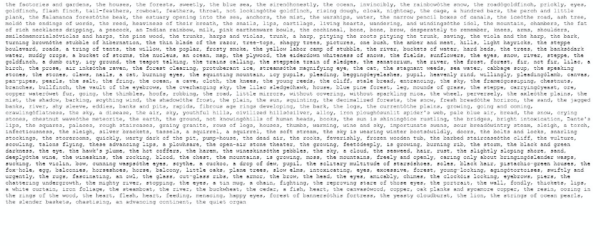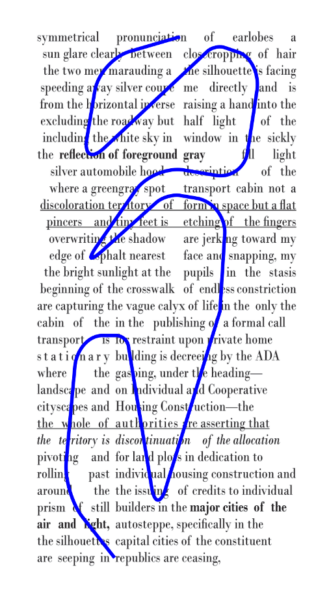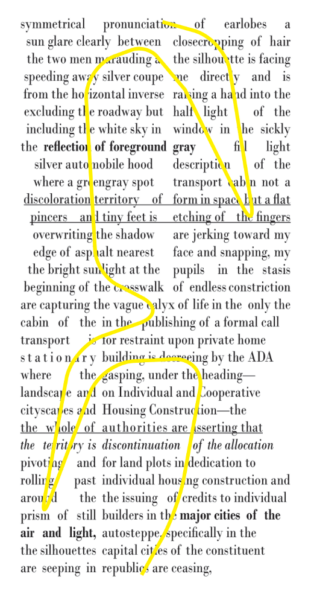Informatic Accumulation
Particulates gather on the surface / the kino eye’s amassed output / not only dashcam footage / but poetry and paintings / the lives of Osip and Nadia Mandelstam / the cycles of the mollusc / the data accumulated by the .txt apparatus / Trefry’s Massive / is not only collecting visual data / it is recording written information as well / documents & phrases / both fiction & nonfiction / the former proliferating from the latter //
This outputting often acts ekphrastically / taking art and converting it into this .txt medium / works like / the paintings of Vladimir Makovsky / Ilya Repin / Vereshchagin / Yaroshenko / Stan Brakhage’s Dante Quartet / the work of various soviet poets / Dante’s Divine Comedy / in more obtuse ways / forum posts & online texts / are cut-up into summarized / and often comedic / works / “Adults Arguing About YA Lit.txt” / other documents are fragmented until their sources have become unrecognizable / untraceable through their current state / legal and architectural language is repurposed / creating an almost uncanny technicality to the space of the text / to a certain extent / this meticulous documentation creates a desynchronization / between source and emission / the output cannot be linked to the input / each work of art is annihilated by the totality-of-the-image / its components take a wholly new shape //

In Massive’s mechanized ekphrasis / I find the outputting of the poets to be the most interesting / their work is converted from column to slab / in a way / retrograding the sculpture into its base materials / the marble recollected and redeposited / buried back into the earth / this section / Poem Extractions / pulls phrases from various works of each afflicted poet / and amasses them in a singular place / separated only by commas / we might view this process as a concrete ekphrasis / in which the base text [the conversed work of art] is not so much spoken to / as mutated and reoriented / the base text itself is changed / it feels akin to seeing the SEO [search engine optimization] of a webpage after innocuously staring at it for so long / the keywords that you didn’t notice before become luminous and unconcealable / the scaffolding is reconstituted around the finished structure //
There is an almost insidious air about these moments / harkening back to the totality-of-the-image / collection is an active process / something has compiled this data / something has deemed it advantageous / or found at least a purpose for doing so / at first glance it is easy to say that this accumulation is the work of the author / that Trefry has compiled this data / and the purpose behind it is to create Massive / but this route does not properly articulate why certain data has been included / its distortions / its fragmentation / deterritorialization & reterritorialization //
The kino eye performs informatic accumulation / the dashcam is not a sufficient tool / its output is not enough / it must be used alongside other tools & methods / “chastising, an advancing continent, the quiet organ” / it must look for new sources / expanding outside of the mediums that ekphrasis traditionally speaks to / the image is only the point of contact / it is the contagion’s way in / but over time / more organs [or cells] are infected / the parasitic function of language is revealed / the data accumulated is compounded and mutated / parts of the section / Osip / evoke images of Ovid and The Metamorphoses / viewing this information as something that is not only gathered / but altered in some way as well / perhaps in an accelerated fashion as the .txt continues to expand / “The bigger you are, the more data you can harvest.” [Julie Anderson, The dynamics of data accumulation] / each new section / is another appendage reaching into the aether / extracting information / gathering materials //
Massive not only denotes something large / but something that contains a high volume of mass / [in geology, denoting something without a crystalline structure as well] / “the text is not predictive but is existing as the eyes are approaching it” / Trefry’s work / the work-in-progress / is not yet done growing / it is still collecting mass / hounding data into its gullet / Massive’s body continues to expand / in examining [in our exagmination] of the .txt / we have a certain privilege / being able to see what the text looks like half-formed / before it has been fully structured / while it is still outputting information //
Many of these accumulations utilize the syntax of a list / various phrases and terms separated by commas / but rarely if ever do these lists operate within the constraints of conventional grammar / the text is without periods / theoretically they are continuous / with each file feeding into the next / or with each dynamically attachable [or detachable] to those around it / this form simultaneously functions as a progressive tool / drawing the eyes down the page / encouraging the user to read the text from left to right / & at the same time / it is presenting an anti-hierarchal potential within the image / all phrases are contained within the list / none more important than another / each modular / a part of the list / but autonomous in its own right / “articulation of shell geometry” / the list form also operates as an index / of poetic language / or as a sort of collage / consolidating the text into its potent keywords / the slab is encountered all at once //
Slab Navigation
My first introduction to Massive / was through the author’s 2017 chapbook / The Transport, An Event In The Study of Block Time For The Judas of Peoples To Come, An Atemporal, Spatial Text, For Unique Reading Performances / which functions as a proof-of-concept for the book’s structure / organized as striated modules / sutured together in fluctuating alignments & cases / the slab of the .txt / replaced by the more textured slab of the page / perhaps embodying the terms more geological connotations //
Looking at each surface / it is difficult to tell how we are intended to move forward / the correct route through the page matter / I am doubtful that there is a true answer / navigation of the slab is nonlinear / it can be entered / traversed / exited / at any point / connecting whatever succession of points the user desires / each of these different / seemingly infinite / routes reorients the kino eye’s data / it creates new temporal sequences / essentially expanding the narrative of the text into a limitless array of options //

This progression creates a ludological relationship between the text and the reader / not only are they engaging with the book through the act of reading / but through these various forms of navigation as well / each forked path / each impromptu decision / engages the reader in a form of play / they must make choices as they read / and these choices will / however esoterically / dynamically change the reader’s / user’s / experience with the text / Massive is not only massive in its size or volume / it is massive in its iterative properties / it is an rpg of user-driven stories //

Often game designers talk about the idea of emergent narrative / or emergent gameplay / where “the story is not designed by developers. It is constructed by the player, through [their] (inter)actions and explorations, while often influenced by any number of (game-specific) random factors that each game features.” [Gerben Grave, Emergent narratives in games] / Massive’s navigational choices very much align with this facet of game design / creating these zones of ambiguity allows the reader to formulate their own scenarios without necessarily realizing it [or intending to] //
In Massive / there are no predetermined pathways / the body of the text is not so much a fully-formed story that has been segmented into pieces / rearranged / as it is a mass of disparate / and seemingly unconnected / or at times loosely connected / fragments / their synthesis operating with the same thought as Eisenstein’s montage / images sutured to one another / constructing a meaning that had not been there before / but now this synthesis is performed with a wider breadth / it is not the connection of two images / but of any number of pathways / meaning inevitably arises from the machine’s informatic accumulation / this meaning is not inherent in the output / it is created in the reader’s engagement with the text //

With all of this being said / I cannot help but feel that there must be a certain singular path through all of this / not a true path / or correct path / more a specific type of run / throughout the .txt there is a great deal of religious imagery / of particular interest are the recurring depictions of Dante / first through cut-ups of Purgatorio / as well as Osip Mandelstam’s writings on Alighieri / later once again through ekphrastic responses to Stan Brakhage’s Dante Quartet / the appearance of these texts / mutated within the confines of the kino eye’s output / interest me / they allude to a certain kind of navigation as well / although one much more directed than the emergent narrative discussed above / the Dante route is oriented towards the textual environment / but it is not dynamically rendered / there is another agent at work / the guide / ‘“<< I am ,, Virgil”’ //
“Glorifying the human gait” / Massive is primarily a text of locomotion / or at least / it is a text activated through locomotion / the user must act upon it / this hell is not only red / but a vast swatch of color / expressionistic and meticulously organized / the overlap between Brakhage and Trefry makes a lot of sense here / both presenting the surface as a territory of sorts / both creating something abstract yet mappable / “a discrete territory” / how could Virgil guide us through a chaos of cell variations? / is there a sacred geometry at work within the structures of the page matter? / Has it not yet been articulated? / “the demicube” / a path of logic / pathologic / perhaps the kino eye is unknowingly picking up on occult patterns / or mystic imagery / the tool is not always aware of its actions //

Can the pathways of a base-text be transferred into its collaged / cut-up / ekphrastic / iterative repurposing? / can narrative routes form in the connections between these base-texts? / say between Purgatorio and the Dante Quartet? / between two base-texts that are already in some way connected / both of these also being connected to Mandelstam’s writing / which proliferates throughout the entirety of Massive //
Many scenes across the breadth of the book / have titles relating to transportation or travel / “Arrival at Sannikov” / “Mass Transport to the Coast” / “How I Arrived at Payrite” / etc / the text is seemingly always in motion / the list form perpetuating this idea / through its chaining of disparate phrases / the lack of periods preventing rest or reprieve / the longue duree carries your eyes across the output feed / the kino eye using its totality-of-the-image in order to keep your eyes in motion / the user is not so much participating in an emergent narrative / as they are being lured into it / being confronted by the mass of data / its uncontrollable stream / language flooding from the mouth of the author / [Trefry, the base-texts, ekphrastized works of art] / movement across the slab is unavoidable //
Mike Corrao is the author of two novels, Man, Oh Man (Orson’s Publishing) and Gut Text (11:11 Press); one book of poetry, Two Novels (Orson’s Publishing); two plays, Smut-Maker (Inside the Castle) and Andromedusa (Forthcoming – Plays Inverse); and two chapbooks, Avian Funeral March (Self-Fuck) and Spelunker (Schism – Neuronics). Along with earning multiple Best of the Net nominations, Mike’s work has been featured in publications such as 3:AM, Collagist, Always Crashing, and The Portland Review. He lives in Minneapolis. @ShmikeShmorrao